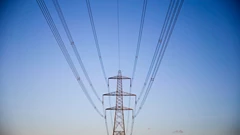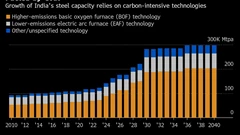Americans Have Always Bought Too Much Car. Now They’re Doing It With EVs
(Bloomberg) -- For US electric car shoppers, the magic number on range seems to be about 300 miles: In a survey commissioned by Bloomberg, nearly two-thirds of 5,500 respondents said that 300-plus miles of range was adequate to their needs, while less than 10% would settle for 200 or less. A 2021 Cox Automotive survey found similar results: an average desired range of 341 miles among people considering EVs.
Yet there is a glaring disconnect between what American drivers want and what they actually need: Some 95% of US car trips are 30 miles or less.
“We’re in this education phase of electrification,” says Stephanie Valdez-Streaty, director of EV research and development at Cox Automotive Mobility. “We’re getting consumers to understand: How often do I drive? Where am I going to be able to charge? What do I need for my lifestyle? As consumers start to get more educated, they may realize they don’t need a vehicle that has a 400-mile range.”
For now, automakers are responding in kind to Americans’ outsized range expectations, introducing more EVs with bigger, longer-lasting batteries and eliminating smaller models. Of the more than 80 EV models and their various trims currently available in the US, all but three — the BMW Mini Cooper SE, the base model of the Nissan Leaf, and a smaller battery version of the Porsche Taycan — come with at least 200 miles of range. Nearly 40% come with at least 300 miles.
Buying too much car is an American tradition that predates the emergence of electric vehicles. The US is, after all, the country that decided the Hummer would make a good car for trips to the mall. But while overbuying on a combustion-engine vehicle usually means getting more seats, cargo space or horsepower than is routinely necessary, with an electric car it means getting too much battery.
Buying an EV is essentially buying a battery on wheels — the lithium-ion batteries that power electric cars are their single most expensive and heaviest component. This makes bloated batteries doubly wasteful: Buyers spend thousands of dollars on range that they will rarely take advantage of, and vehicles spend kilowatts carrying around the excess weight. More battery also means more greenhouse gas emissions — undermining the impetus for switching to EVs in the first place — as well as added danger for other road users.
For a good guidepost on what it takes to build the EVs Americans say they want, it helps to do some back-of-the-envelope math. Across the 80-plus models in Bloomberg’s EV Ratings — all of the models currently for sale in the US — the median efficiency is 3.3 miles of range per kilowatt hour (kWH) of battery. That means 300 miles of range requires about 91 kWh.
According to BloombergNEF’s most recent price survey, battery packs cost automakers an average of $118 per kWh. So one 91 kWh battery is likely to cost nearly $11,000 to make. And at an average energy density of about 174 Watt-hours per kilogram, according to BloombergNEF, that $11,000 battery typically weighs in at more than 1,100 pounds.
Whether that weight and expense is worth it for what mostly amounts to commutes and grocery-store trips is an open question for drivers and automakers. “For every kilowatt hour of battery, we add cost for the consumer, and we add CO₂,” says Fredrika Klarén, head of sustainability at Sweden-based EV maker Polestar, which sells a performance sedan with 270 miles of range and a 78 kWh battery.
The American market’s glut of big EVs stands in contrast to the growing array of small electric cars being sold across Europe, Asia and elsewhere. But in the US, where EV adoption is currently hovering around 5%, the overbuilt electric car may be a necessary evil — one that gets that Hummer-driving mall-goer to first consider switching to an electric Hummer, and then maybe eventually a modest EV sedan.
“We have to get more people on board, really trusting EVs and feeling confident enough to buy them,” says Klarén. “They need to feel like they have good range to be able to make that leap from ICE vehicles.”
As more drivers gain experience with EVs and become more comfortable with charging routines, says Valdez-Streaty, range anxiety will probably give way to range confidence and second-time EV buyers may be more inclined to downsize. By then the offerings are likely to be more diverse, with more low-cost and lower range models in the mix. “If we want mass adoption,” she says, “we need a price point for everyone and something that meets their lifestyle.”
It’s also possible that, in the long run, American EV drivers will be able to have the range they want without hulking, expensive batteries. Well-funded startups and big automakers are working to develop alternative battery chemistries that deliver abundant range without the bulk. If these options follow the trend of lithium-ion battery packs, prices will eventually come down to a level that makes them available to the broader market. For now, though, the long-range, low-cost, lightweight electric car remains a fantasy.
More stories like this are available on bloomberg.com
©2022 Bloomberg L.P.
KEEPING THE ENERGY INDUSTRY CONNECTED
Subscribe to our newsletter and get the best of Energy Connects directly to your inbox each week.
By subscribing, you agree to the processing of your personal data by dmg events as described in the Privacy Policy.
More renewables news

House Committee Says It Finds Evidence of ‘Climate Cartel’

WEC Energy Offered $2.5 Billion US Loan for Renewable Projects

With Trump Looming, Biden’s Green Bank Moves to Close Billions in Deals

GE Vernova Expects More Trouble for Struggling Offshore Wind Industry

Climate Tech Funds See Cash Pile Rise to $86 Billion as Investing Slows

GE Vernova to Power City-Sized Data Centers With Gas as AI Demand Soars

Longi Delays Solar Module Plant in China as Sector Struggles

Australia Picks BP, Neoen Projects in Biggest Renewables Tender

SSE Plans £22 Billion Investment to Bolster Scotland’s Grid
















